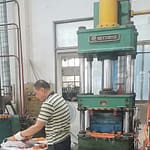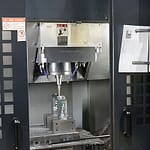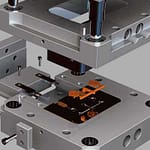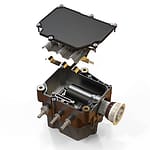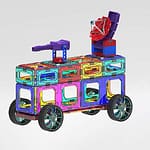Home Appliances Made from ABS
ABS Plastic: Properties, Advantages, Disadvantages, and Industrial Applications
ABS (Acrylonitrile Butadiene Styrene) is one of the most widely used engineering thermoplastics in manufacturing today. Its unique combination of mechanical strength, aesthetic appeal, and cost-effectiveness makes it a popular choice across various industries, from consumer products to automotive and electronics.
Key Properties of ABS Plastic
Impact Resistance: ABS is valued for its exceptional toughness and ability to absorb shocks without cracking.
Mechanical Strength: It provides outstanding tensile strength and rigidity, supporting its use in structural and load-bearing parts.
Processability: Easily moulded and machined, ABS is ideal for processes such as injection moulding, CNC machining, and 3D printing.
Chemical Resistance: It offers resistance to various acids, alkalis, and oils.
Electrical Insulation: ABS performs well as an insulating material in electronic components.
Surface Quality: It can be polished or painted to achieve smooth, high-gloss finishes.
LG Chemical TR-557 Transparent ABS
A Typical Example of ABS Properties
LG TR-557 is a transparent grade of ABS resin manufactured by LG Chem, offering a balanced combination of clarity, impact resistance, and processability. It is widely used in applications where both aesthetic appeal and reliable performance are essential.
| Physical Properties | Original Value | Comments |
| Specific Gravity | 1.07 g/cc | ASTM D792 |
| Linear Mold Shrinkage | 0.0040 – 0.0070 cm/cm | ASTM D955 |
| Melt Index of Compound | 20 g/10 min | ASTM D1238 |
| Mechanical Properties | Original Value | Comments |
| Hardness, Rockwell R | 105 | ASTM D785 |
| Tensile Strength at Break | 41.19 MPa | ASTM D638 |
| Elongation at Break | 40% | ASTM D638 |
| Flexural Strength | 63.74 MPa | ASTM D790 |
| Flexural Modulus | 1.99 GPa | ASTM D790 |
| Izod Impact, Notched | 147.1 J/m | ASTM D256 |
| Thermal Property | Original Value | Comments |
|---|---|---|
| Maximum Service Temperature, Air | 90.0 °C | Heat deflection temperature, load unknown; ASTM D648 |
| Flammability, UL94 | HB |
| Optical Properties | Original Value | Comments |
| Haze | 2.00% | |
| Transmission, Visible | 89.50% |
| Processing Property | Original Value | Comments |
|---|---|---|
| Processing Temperature | 190 – 200 °C | Extrusion cylinder temperature, C1 |
| 210 – 225 °C | Extrusion cylinder temperature, C2 | |
| 230 – 240 °C | Extrusion cylinder temperature, C3 | |
| 240 – 250 °C | Extrusion cylinder temperature, C4 and C5 | |
| Rear Barrel Temperature | 190 – 200 °C | |
| Middle Barrel Temperature | 200 – 220 °C | |
| Front Barrel Temperature | 210 – 230 °C | |
| Nozzle Temperature | 210 – 230 °C | |
| Adapter Temperature | 235 – 245 °C | |
| Die Temperature | 235 – 245 °F | |
| Melt Temperature | 220 – 240 °C | Injection moulding |
| 255 – 260 °C | Extrusion | |
| Mold Temperature | 40.0 – 60.0 °C | |
| Roll Temperature (Bottom) | 75.0 – 85.0 °C | |
| Roll Temperature (Middle) | 80.0 – 90.0 °C | |
| Roll Temperature (Top) | 85.0 – 95.0 °C | |
| Injection Pressure (Second) | 68.65 – 88.26 MPa | |
| Injection Pressure (First) | 58.84 – 98.1 MPa | |
| Back Pressure | 0.490 – 1.96 MPa | |
| Screw Speed | 50 – 100 rpm |
Advantages of ABS Plastic
Excellent Impact resistance.
ABS is highly resistant to physical impacts, making it suitable for products such as protective gear, tool casings, and children’s toys.
Strong and Rigid
Its strength and rigidity make it suitable for parts that require dimensional stability, such as automotive dashboards and enclosures.
Versatile Manufacturing
Compatible with a wide range of manufacturing methods, including:
- Injection moulding—for high-volume production
- 3D printing—common in prototyping and custom parts.
- Machining is suitable for detailed components.
Chemical and Electrical Resistance
Common in laboratory equipment and electrical housings, ABS resists many chemicals and acts as an effective insulator.
Attractive Surface Finishes
ABS parts can be easily painted, chrome-plated, or textured, making them ideal for both functional and decorative uses.
Disadvantages of ABS Plastic
Poor UV and Weather Resistance
Standard ABS can degrade when exposed to sunlight, leading to yellowing and brittleness over time. UV-stabilized ABS is recommended for outdoor applications.
Flammable
ABS is flammable and, when ignited, may release harmful fumes. Flame-retardant ABS variants are available but cost more.
Limited Heat Resistance
With a typical softening point of around 200–240°C, ABS may not be suitable for high-heat environments such as engine bays or heating devices.
Dimensional Instability
ABS has a high thermal expansion rate, which can affect dimensional accuracy under temperature fluctuations, which is critical in high-precision applications.
Choosing the Right ABS Grade:
When selecting ABS (Acrylonitrile Butadiene Styrene) for manufacturing, it’s essential to consider specific grades tailored to particular performance needs. Variants such as flame-retardant ABS, ABS/PC blends, and UV-resistant ABS offer enhanced functionality for demanding environments.
Flame-Retardant ABS (ABS FR)
Ideal for electrical housings and public-facing equipment, ABS FR meets fire safety standards like UL 94 V-0. It offers excellent rigidity and is available in halogen-free formulations.
Used in: Consumer electronics, power tool casings, switchgear, kiosks.
ABS/PC Blends
Combining ABS with polycarbonate enhances impact strength and heat resistance, making it perfect for durable, high-performance components.
Used in: Automotive interiors, mobile devices, laptops, structural parts.
UV-Resistant ABS
Stabilised with UV additives, this grade is suitable for prolonged outdoor use, maintaining its appearance and strength over time.
Used in: Outdoor enclosures, garden tools, automotive trims, sports gear.
Applications of ABS Plastic
Acrylonitrile Butadiene Styrene (ABS) is a highly versatile thermoplastic used extensively across multiple industries due to its excellent impact resistance, strength, ease of processing, and attractive surface finish. Below are some of the key sectors where ABS plastic plays a vital role:
1. Consumer Electronics
ABS material is widely used in the manufacture of consumer electronics, including:
- Computer peripherals (keyboards, mice)
- Remote controls
- Mobile phone housings
- Audio-visual equipment casings
Its inherent electrical insulation, dimensional stability, and resistance to impact make it ideal for protective and aesthetic enclosures in electronic devices.
2. Automotive Industry
ABS plastic is a staple material in automotive design, particularly for functional and decorative components. Common applications include:
- Dashboard and instrument panel trim
- Door panels and pillar covers
- Grilles and mirror housings
- Interior console parts
The material’s balance of toughness, low weight, and good surface quality enables manufacturers to reduce costs while maintaining high durability.
3. Toys and Educational Products
One of the most famous uses of ABS is in toy manufacturing—LEGO bricks are a prime example. Its benefits in this sector include:
- Excellent mouldability for intricate shapes
- High impact resistance, ensuring safety
- Vivid colour retention and surface polish
ABS’s non-toxic formulation (when manufactured for compliance) further supports its use in child-safe products.
4. Household Appliances
ABS is found in a wide array of small domestic appliances due to its:
- Resistance to chemicals and heat
- Structural strength and stiffness
- Attractive, easy-to-clean surface
Applications include vacuum cleaners, coffee machines, food processors, and microwave components.
Medical Devices and Equipment
Non-implantable medical equipment uses ABS plastic, particularly when sterilisation and durability are necessary. Typical uses include:
- Housings for diagnostic and monitoring devices
- Laboratory instruments
- Disposable syringes and casing components
Its resistance to chemicals and ease of sterilisation make it particularly well-suited to medical environments.
Sports and Recreational Equipment
ABS is employed in the production of durable, lightweight sporting goods, such as:
- Helmets and protective gear
- Bicycle parts
- Skateboards and ski components
Its impact strength and weather resistance help ensure long-lasting performance, even in demanding outdoor conditions.

